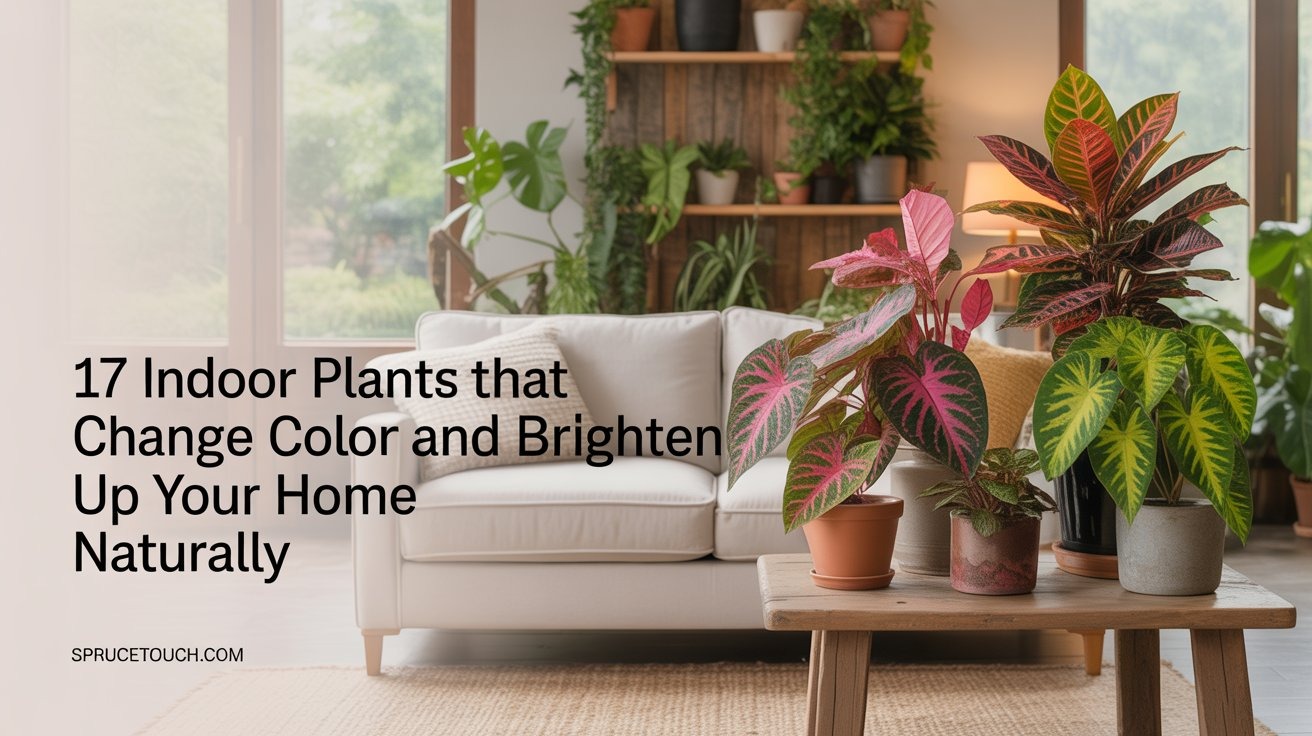If you’ve ever wished your living room could shift shades with the seasons — without repainting or buying new décor — indoor plants that change color are the magical solution. These plants bring subtle (and sometimes dramatic) transformations, from vibrant pinks and reds to golden yellows and deep purples. They don’t just sit pretty; they evolve right before your eyes, making your space feel alive and ever-changing.
I started experimenting with these types of plants after realizing my houseplants all looked the same green year-round. The color-changing ones brought a whole new level of excitement, like having a tiny autumn forest or a living bouquet indoors. They’re also great conversation starters when guests come over and notice that your leaves are suddenly blushing red or shimmering bronze.
In this post, I’ll share 17 of the most stunning indoor plants that naturally change color, along with care tips and photo inspiration so you can imagine how they’ll look in your own home.
1. Croton – A Rainbow in Leaf Form
Croton is one of those plants that feels like fireworks went off in your living room. Its leaves often start green, then streak with fiery reds, oranges, and yellows. The more light it gets, the more dramatic the color show. When I first brought mine home, it stayed mostly green, but after moving it closer to a bright window, it exploded into shades I didn’t even know it had.
Crotons love warmth and humidity, so if your home gets dry in winter, try misting the leaves or placing a humidifier nearby. They’re also a bit dramatic — drop a few leaves here and there if they’re not happy — but don’t worry, new ones sprout quickly.
The transformation is especially beautiful in fall, when their fiery palette echoes the season outside. It’s like having a piece of autumn indoors year-round.
2. Coleus – The Painter’s Plant
Coleus is technically an outdoor annual in many places, but it grows beautifully indoors if given bright light. The colors are almost unreal — deep burgundy, chartreuse, magenta, and even speckled combinations that look painted on. What’s fun is that the colors can change depending on light exposure and temperature.
I had a lime-green and burgundy variety that turned a shocking magenta in summer when it got more sunlight. Indoors, they thrive in bright indirect light, and if you pinch off the growing tips, they stay bushy instead of leggy.
Coleus is also a great plant for people who like experimenting, since you can easily propagate new plants from cuttings and watch each one reveal slightly different colors.
3. Nerve Plant (Fittonia) – Blushing Veins
The nerve plant is small but mighty when it comes to color impact. Its green leaves are shot through with veins of pink, red, or white, and these veins often deepen or shift shades with lighting conditions.
I love keeping mine on my office desk because it adds a soft pop of color without overwhelming the space. Fittonia is a humidity lover, so it thrives in terrariums or near other moisture-loving plants. If the leaves get droopy, it’s basically the plant’s way of saying, “Hey, water me!”—but the good news is it bounces back almost instantly.
This little plant’s changing tones feel almost alive in a way — as if it’s constantly reminding you to slow down and notice the details.
4. Caladium – Living Stained Glass
Caladium is one of my absolute favorites because its leaves look like stained glass. Depending on the variety, you’ll see a kaleidoscope of pinks, reds, whites, and greens, and these colors shift subtly as the leaves mature.
They prefer bright, indirect light indoors and like to stay consistently moist. What’s fun is that each new leaf often emerges with slightly different coloring, so your plant always looks like it’s wearing a new outfit.
Caladiums tend to go dormant in winter, so don’t panic if yours fades — it will spring back in the warmer months, often with even more vibrant colors.
5. Ti Plant (Cordyline) – Tropical Fireworks
Cordyline, also known as the Ti plant, is like a tropical firework display in plant form. Its long leaves often start green but transform into streaks of pink, purple, or burgundy depending on the light.
I placed one near my entryway, and the pink tones deepened beautifully with the morning sun shining through. They’re hardy and easy to grow indoors, making them a great pick for people who want a tropical vibe without a ton of fuss.
Pairing them with neutral décor makes their colors really pop — think white walls, light wood furniture, and a Ti plant stealing the spotlight.
6. Rubber Plant (Ficus elastica) – From Green to Bronze
Rubber plants are a classic indoor plant, but the color-changing varieties deserve special attention. Their new leaves often emerge a lighter green or reddish bronze before maturing into a glossy deep green or burgundy.
I love how this creates a layered look — one plant gives you multiple shades all at once. Plus, they’re incredibly low-maintenance, handling everything from bright indirect light to lower light conditions.
For a bold design statement, group a burgundy variety with lighter green houseplants for contrast. It instantly elevates the whole room.
7. Chinese Evergreen (Aglaonema) – Pink and Silver Drama
Chinese evergreens are one of the most forgiving indoor plants, but don’t let that fool you — some varieties are absolutely dazzling. Leaves can be patterned with silver, red, or pink, and those tones often change intensity with age and light.
I have a pink aglaonema that started with soft blush tones, but as it matured, the leaves deepened into a vibrant hot pink that almost glowed under natural light.
They’re fantastic for adding unexpected color to low-light spaces like hallways or bedrooms where other plants might struggle.
8. Polka Dot Plant (Hypoestes) – Freckles in Flux
The polka dot plant is playful, with green leaves dotted in pink, white, or red. What makes it fascinating is how those freckles can shift in intensity depending on how much light it gets.
I once had one that started with soft pink freckles, but after a summer in a sunnier spot, the dots deepened into a rich crimson. Indoors, they stay small and compact, making them perfect for shelves or coffee tables.
They do prefer a bit of extra care — regular watering and pruning to prevent legginess — but the reward is a constantly shifting pop of cheerful color.
9. Bromeliads – Colorful Surprises
Bromeliads are showstoppers that change color dramatically when they’re about to bloom. Their central leaves often shift from green to bright red, orange, or purple, making it look like the plant is glowing from the inside out.
The first time mine changed, I thought something was wrong — but nope, it was preparing to flower. They thrive in bright indirect light and need a little water in their central “cup.”
Once they’ve bloomed, the mother plant eventually fades, but don’t worry — they produce pups that you can pot up and continue the cycle.
10. Prayer Plant (Maranta) – Moving and Changing
Prayer plants are unique because they don’t just change color — they also move. Their green leaves are patterned with red or pink veins that often darken or lighten depending on the light, and at night, the leaves fold up like praying hands.
I keep one on my bedside table, and it feels like a living companion, following the rhythm of the day. The shifting tones of green, red, and even purple add depth and interest.
Pair it with other low-light plants for a lush corner that feels alive even in dim spaces.
11. Begonia Rex – Dramatic Color Shifts
Begonia Rex is one of the most dramatic houseplants you can own. Its large, textured leaves can change between green, silver, pink, purple, and even black depending on the season and lighting.
I had one that looked almost entirely silver in winter but transformed into deep purple and magenta during summer. It’s like getting multiple plants in one.
They do need a bit more attention (consistent moisture and humidity), but the show is well worth the effort.
12. Kalanchoe – A Flowering Surprise
Kalanchoe is often sold as a flowering plant, but its leaves can also take on reddish edges when given enough sunlight. The flowers themselves last for weeks, changing shades slightly as they age.
I love keeping one in the kitchen window, where the bright light encourages both blooms and leaf coloration. They’re low-maintenance succulents, so watering every week or two is usually enough.
The shifting tones make them feel like a fresh bouquet that never really fades.
13. Wandering Jew (Tradescantia zebrina) – Shimmering Stripes
Tradescantia zebrina is famous for its shimmering, striped leaves. Depending on the light, they shift between green, purple, and silver, almost like velvet.
I hung mine in a macramé planter near a bright window, and the cascading vines caught the sunlight beautifully. The color shifts make them look almost otherworldly, but in a cozy, inviting way.
They’re also super easy to propagate, so you can create a whole family of shimmering plants from just one.
14. Peacock Plant (Calathea makoyana) – Nature’s Artwork
Calatheas are known as “drama queens,” but their beauty makes up for it. The peacock plant has leaves patterned with cream and green that shift subtly as they mature, with purple undersides that create contrast when the leaves move.
They like humidity and indirect light, but if you’re willing to pamper them, they reward you with a constantly evolving display.
I love placing them where people can walk by and notice the underside flash of purple as the leaves shift.
15. Oxalis Triangularis – Purple Butterfly Leaves
Oxalis is often called the purple shamrock, but its real magic is in the way the leaves open and close daily like butterfly wings. Their shades shift from deep purple to lighter pink depending on the light.
I keep one on my windowsill, and it’s fascinating to watch it move throughout the day. When it blooms with tiny white or pink flowers, the effect is delicate and enchanting.
It’s a conversation piece that brings both movement and color change into your home.
16. Coleus Black Dragon – Dark Drama Indoors
For something more dramatic, the Black Dragon coleus is incredible. Its leaves shift between maroon, purple, and near-black, with ruffled edges that look almost gothic.
I paired mine with light-colored décor, and it looked like a piece of living artwork. The tones deepen in brighter light, giving you a moody vibe indoors.
It’s a fun plant for people who want something a little edgier than the typical green houseplant.
17. Anthurium – Glossy Leaves and Changing Blooms
Anthuriums are known for their glossy, heart-shaped blooms that often shift color as they mature — from green to red, pink, or orange. Even the leaves themselves can show subtle changes over time.
They love bright, indirect light and consistent watering, and they add a touch of elegance to any room. I like keeping one in the dining area, where guests can admire its ever-changing flowers.
It’s a plant that feels both tropical and classy, perfect for brightening up any space.
🌿 If you love plants that change with the seasons, you might also enjoy our post on 17 Cottage Garden Climbing Flowers for a Charming Outdoor Space or explore some of the Best Perennial Plants to Use for Borders for your garden.

